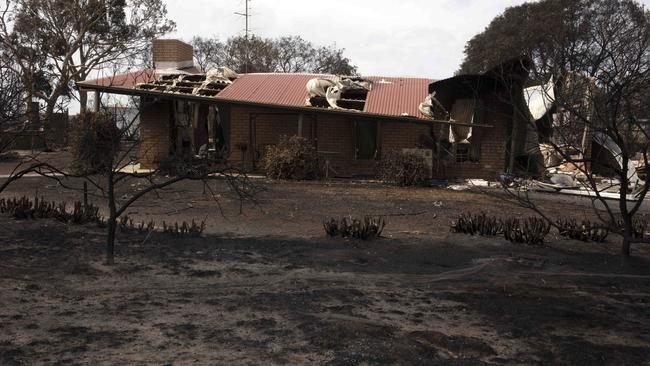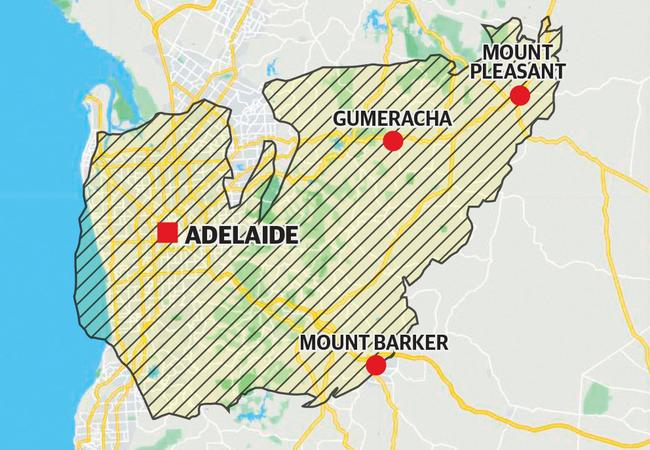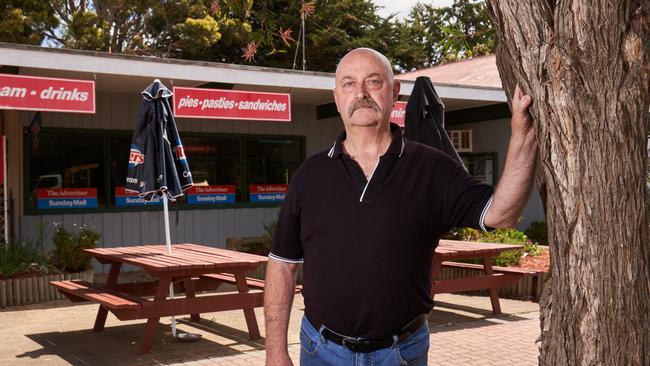Distressed farmers forced to put down thousands of livestock injured in Kangaroo Island fires
About 100,000 sheep and cattle are being destroyed by farmers traumatised by the Kangaroo Island bushfires, as volunteers also try desperately to aid thousands of injured native animals.
SA News
Don't miss out on the headlines from SA News. Followed categories will be added to My News.
Traumatised farmers who lost their homes on Kangaroo Island have faced the heartbreaking task of killing injured livestock in the aftermath of the devastating fires.
An estimated 100,000 sheep and cattle are being destroyed across the northern and western sides of the island, with some properties running out of ammunition.
The carcasses of hundreds of cattle, sheep, kangaroos, wallabies, foxes and wild pigs which tried to escape the fires lined roads, which was also littered with the remains of houses, sheds, vehicles and farming equipment.
At least 50 homes belonging to farming families are believed to have been lost in the two fires which have burned on Kangaroo Island since December 20, the most recent last Friday wiping everything in its path.
Occupants spent Sunday not sifting through the remains of their houses but on their blackened paddocks, either euthanising injured animals or moving survivors to areas not ruined by fire.

Attorney-General Vickie Chapman, a sixth-generation Kangaroo Island farmer, said destroying livestock was one of the most traumatic events a farmer could experience.
Ms Chapman, whose farms at Western River suffered extensive damage, told The Advertiser during a tour of the fire zone that farmers often swapped with neighbours to perform the grim task.
“The first priority for farmers when there has been a fire is to put down any animals which are injured and in pain,” she said. “It is better to go and do your neighbours’ than your own. It’s not a job you can do on your own and survive emotionally.”

Sedan farmer Paul Burgemeister, who came to KI with two mates to help farmers destroy livestock, said it was one of the most traumatic events for farmers.
“There is the death of people, then there is the loss of the family home and then there is the death of animals,” he said.
“They are the top three. After that there are the sheds, other infrastructure, machinery but they are a world apart.”
Many of the farming properties destroyed by the fires were originally started by veterans from World War II, under the soldier settlement program in the 1950s.
Ms Chapman, who has experienced numerous large fires on the island including an inferno in 1974, said there were several families on the island who had lost multiple homes, hundreds of kilometres of fencing and thousands of sheep and cattle.
Kangaroo Island Mayor Michael Pengilly said it would take at least two years for the island’s agricultural sector to recover from the fires, which have burnt 155,000ha.
Mr Pengilly said fencing needed to be repaired before there could be any restocking, with many burnt paddocks unable to sustain grazing.
“Tens and tens of thousands of sheep and cattle have been lost,” he said.
“Many people are now facing two years without an income and that is going to be a challenge.”

Mr Pengilly said the other immediate challenge facing the island was damage to critical infrastructure.
“Drinking water is getting desperately short and the mobile phone tower at Gosse has been knocked out,” he said.
SA Water had sent two large water tankers to the island and it was trying to refill a reservoir at Middle River in a bid to shore up water supplies.
“Everybody is working like hell to get everything sorted,” he said.
Mr Pengilly said he was especially grateful to the Federal Government for offering to send 200 soldiers to help with the recovery effort.

His comments came as State Cabinet prepared to hold a special meeting on Monday.
Premier Steven Marshall, who flew over the fire zone on Sunday with Environment Minister David Speirs, said firefighters had done an “incredible job”, particularly with stopping the fire front from reaching the town of Parndana. “While there is much focus on what has been lost, we also need to be focused on what has been saved thanks to our courageous and heroic firefighters,” he said. “The firefighting capacity in South Australia is one which every South Australian can be proud of.”
Mr Marshall said his aerial inspection of the island had confirmed the worst property damage had occurred at its western end, near Flinders Chase National Park.
The luxury Southern Ocean Lodge was gutted, while other tourist attractions including Hanson Bay Cabins, Western KI Caravan Park, Hanson Bay Wildlife Sanctuary and Kangaroo Island Wilderness Retreat were either severely damaged or destroyed.
Mr Speirs confirmed the visitor centre at the Flinders Chase National Park had been “completely reduced to ash” while the park had sustained extensive damage.
Bakery refuge for fire’s lost souls
When Michael Boyd walked out of the Parndana bakery on Friday evening, he watched the northern horizon light up with flames.
It was as bright as the daylight sky and Mr Boyd contemplated leaving the town and the bakery he and wife Jen had owned for 24 years.
But as the siren sounded to evacuate, he decided to stay and keep the doors open for “lost souls” looking for a place to sit and a person to talk to.
“I stayed open late into the night,” he said.
“We kept the lights on and the door opens. There were people who had lost everything walking the street in a daze, looking like lost souls.” Those who didn’t evacuate the town sought shelter on the nearby oval.

In the days since the fire destroyed dozens of homes and levelled popular tourist locations, the couple have heard stories of the devastation.
“On the night, we were hearing worse and worse stories,” Mr Boyd said.
“Every 20 minutes, someone came in and told us of another farm lost.”
The community and the few tourists in the town have already banded together.
Some left money on tab for firefighters to buy food and drink while others brought in clothes for people who have lost everything.
“One woman said that she was at home on the farm and four firefighting units arrived,” Mr Boyd said.
“She hasn’t met any of them before but they stayed and protected her property.
“They never asked for anything, not water or fuel.”
Despite the devastation to the west of the town, Mr Boyd said Parndana and the wider community would survive if the tourist dollars started to flow again.
“People move here for the community,” he said.
“The strongest part of the community is its people.
“We need to get the message out that there are still beautiful parts of the island to see.”
- Mitch Mott

